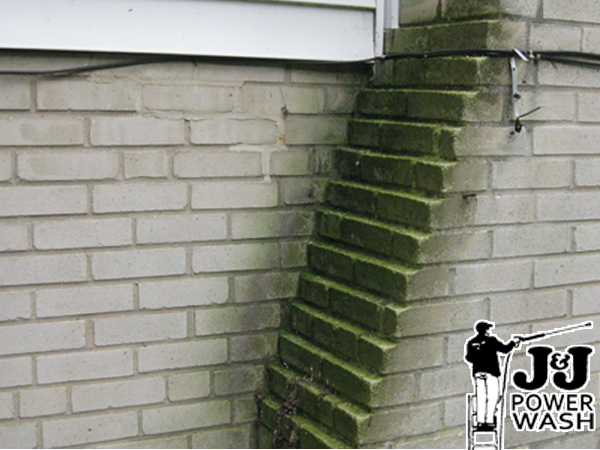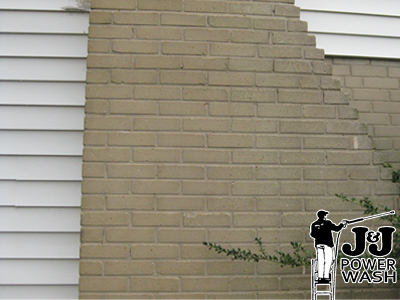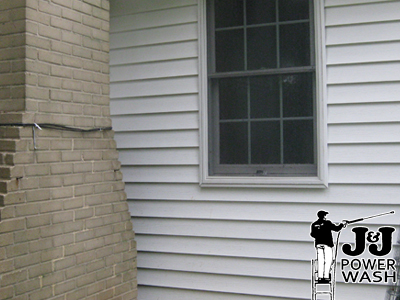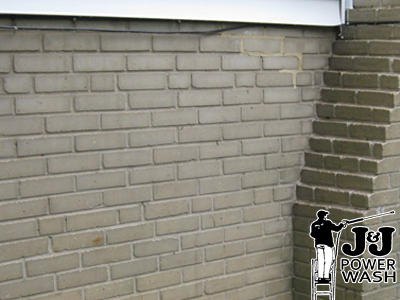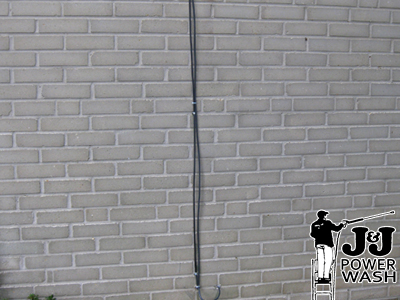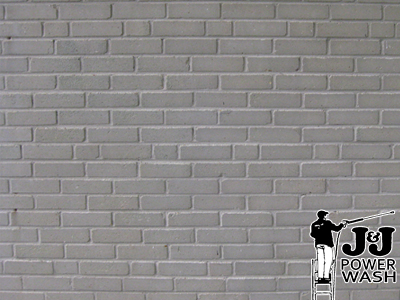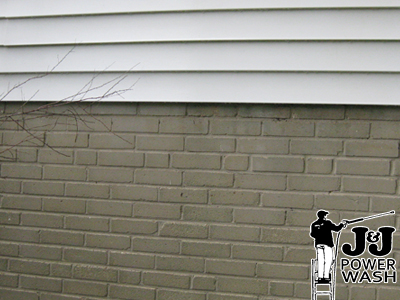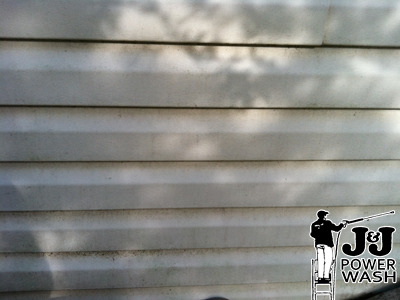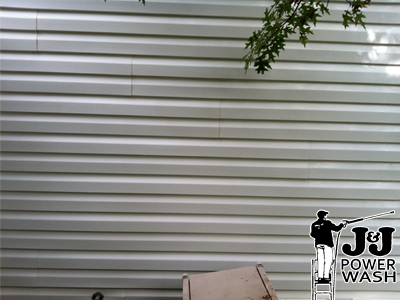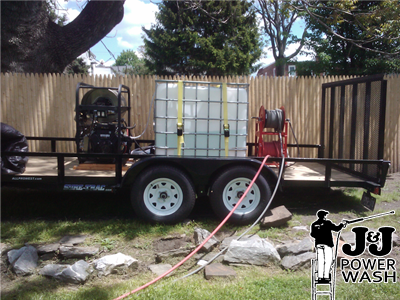There are two ways to pressure wash the gutters on your house. The first is doing it yourself. The second is hiring a pressure washing contractor. If you choose the first way and do not own a pressure washing unit you can rent one for about $75 a day at your local hardware store. Keep in mind you may have to purchase chemicals separately.
If you choose the second way make sure your contractor has either contractor insurance or pressure washing insurance. A powerwashing company will use a machine that is similar to the machine in the below picture. Our trailer contains a hot/cold pressure washing machine as well as a 500 gallon water tank for those of you that do not have access to water.
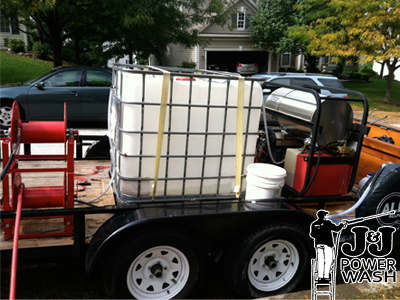
The most important aspect and what makes our pressure washer different from those that are generally rented at a hardware store is the water temperature. Most commercial grade pressure washing machines have the ability to heat water up to 250 degrees to remove those tough stains that may require heat to dissolve like oil spills.
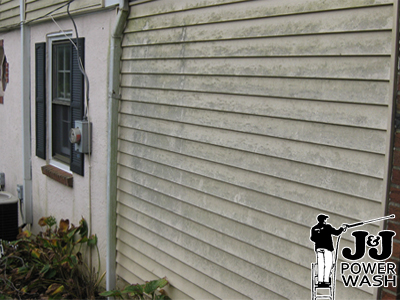
From here, it is a three step process. You spray on whichever chemical you choose (depends on the material you are pressure washing), scrub down any necessary areas, and spray clean. There is really not much too it. You just need to learn which chemical to use on which product. A shingled roof may need chlorine, an asphalt driveway may stronger bleach, while certain types of vinyl siding may need hot water only. In this case you would use gutter cleaner, which you want to wear gloves and eye protection with.
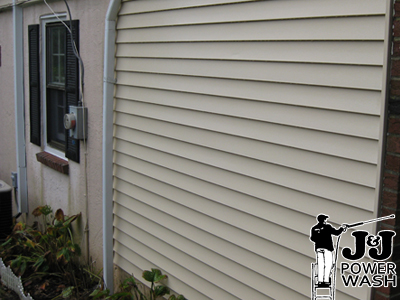
If you choose to go the second way and like the before and after photos pictured above please contact us at 215-703-8306 to setup a free estimate. We offer pressure washing, powerwashing, window cleaning and graffiti removal in the Greater Philadelphia area.
Before and After Pictures – Brick Chimney
Take a look at before and after pictures of a house with brick chimney we cleaned recently. If you are in the Greater Philadelphia area and are in need of pressure washing, power washing, window cleaning, graffiti removal or vehicle cleaning services, contact our Philadelphia Pressure Washing company at 215-703-8306.
How to Pressure Wash your Siding
There are two ways to pressure wash the siding on your house. The first is doing it yourself. The second is hiring a pressure washing contractor. If you choose the first way and do not own a pressure washing unit you can rent one for about $75 a day at your local hardware store. Keep in mind you may have to purchase chemicals separately.
If you choose the second way make sure your contractor has either contractor insurance or pressure washing insurance. A powerwashing company will use a machine that is similar to the machine in the below picture. Our trailer contains a hot/cold pressure washing machine as well as a 500 gallon water tank for those of you that do not have access to water.
The most important aspect and what makes our pressure washer different from those that are generally rented at a hardware store is the water temperature. Most commercial grade pressure washing machines have the ability to heat water up to 250 degrees to remove those tough stains that may require heat to dissolve like oil spills.
From here, it is a three step process. You spray on whichever chemical you choose (depends on the material you are pressure washing), scrub down any necessary areas, and spray clean. There is really not much too it. You just need to learn which chemical to use on which product. A shingled roof may need chlorine, an asphalt driveway may stronger bleach, while certain types of vinyl siding may need hot water only.
If you choose to go the second way and like the before and after photos pictured above please contact us at 215-703-8306 to setup a free estimate. We offer pressure washing, powerwashing, window cleaning and graffiti removal in the Greater Philadelphia area.
How to Clean Brick Siding
Take a look at the after pictures of a house with brick siding we cleaned recently. If you are in the Greater Philadelphia area and are in need of pressure washing, power washing, window cleaning, graffiti removal or vehicle cleaning services, contact our Philadelphia Pressure Washing company at 215-703-8306.
From Start to Finish
Take a look at before and after pictures as well as both videos of setup and pressure washing of a recent 4 bedroom house. If you are in the Greater Philadelphia area and are in need of pressure washing, power washing, window cleaning, graffiti removal or vehicle cleaning services, contact our Philadelphia Pressure Washing company at 215-703-8306.
Setting Up
Pressure Washing
Our New 16 Ft Trailer
If you are in the Greater Philadelphia area and are in need of pressure washing, power washing, window cleaning, graffiti removal or vehicle cleaning services, contact our Philadelphia Pressure Washing company at 215-703-8306.
Transform Backyard into Haven
Published: August 28, 2011 3:00 a.m.
Transform backyard into haven
Rosemary Sadez Friedmann | Scripps Howard News Service
Not inclined to put in a fire pit? So how do you make your backyard patio a relaxing and fun refuge?
According to experts, a good surface, good lighting, good seating, and good cooking and dining spaces are essential. And don’t forget the grill.
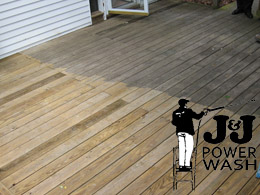
Make Deck Inviting
A crumbling, messy deck isn’t pretty. If your deck is made of wood and still in good condition, go ahead and power-wash it or sand and restain it. If it needs more repair than that, you might consider replacing it with a wood-alternative deck that won’t need that care every year or two.
Some wood-alternative decks come in colors, so you can select one that fits your décor.
Be careful with color, though. Neutral usually works best because an intense color might become annoying over time.
If you have a concrete or brick patio, the power-washing can do wonders, as can a low-cost patterned outdoor carpet that defines a seating area or dining space.
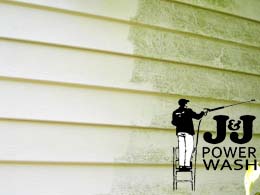
Mini-kitchen
A complete outdoor grilling station can cook a full meal, and this full meal can be prepared while you and your family and friends are enjoying that wonderful backyard. It won’t even seem like work. A rolling two-shelved cart to get items from the house to the grill can add ease.
Upgrade Seating
For a comfortable outdoor haven, you are going to need to get rid of those folding patio chairs.
They work in a pinch, but they certainly don’t make for that backyard-haven thing you’re going for.
Select seating that is comfortable, and be sure the seating is of your liking and not simply something that is on sale. Sales are important, and now is the time to find end-of-season bargains, but don’t be drawn into purchasing simply by the price tag.
Remember that you are creating your own personal vacation spot. Select furniture that is waterproof and won’t need sanding and staining or painting on a regular basis.
Shed some Light
Moveable table-top patio lanterns or flameless candles can provide ambience as well as light. So can lining paths, garden beds or patio edges with good-quality solar lights. Consider lighting large shrubs and trees with small white light strings as you would for Christmas for a magical touch. Or string transparent cables of LED lights along the roof line of the house or patio pergola.
© Copyright 2011 The Journal Gazette. All rights reserved. Neither this material nor its presentation may be published, broadcast, rewritten or redistributed.
If you are in the Greater Philadelphia area and are in need of pressure washing, power washing, window cleaning, graffiti removal or vehicle cleaning services, contact our Philadelphia Pressure Washing company at 215-703-8306.
Do-it-yourself Guide to Painting the Exterior of your Home
Published: Saturday, September 03, 2011, 7:30 AM
By Shannon Quimby, Special to The Oregonian
Editor’s note: Your house is your biggest asset. So if it’s starting to look a little shabby and painting it has moved to your must-do list, don’t be daunted by the prospect. We have information that can help you decide what colors to use as well as what you need to know if you want to paint it yourself. It’s a big project, though, and it comes with a couple of important caveats, so be sure to look at our two previous posts on staying safe on a ladder and what you must know about the danger of lead-based paint.
If your house is looking a little too shabby chic these days and needs repainting, you may want to save a few bucks and tackle the project yourself. But before you hit decision-making overload at the paint store and your head starts spinning with doubt, anxiety and endless questions, read these no-nonsense painting tips. In no time you’ll create a dramatic change. It’s one of your least-expensive ways to increase the value of your home.
BEFORE YOU BEGIN
Plan when to paint. In the Pacific Northwest, the painting season for house exteriors is late spring to early fall.
Head to your favorite paint store to stock up on materials and tools. Don’t be shy to ask the experts what you’ll need: They do this all day long.
Clear the surrounding area of furniture, flowerpots, hoses, garbage cans, cars and large debris.
Look up and check under the eaves for beehives and bird or wasp nests. Remove with care.
Make sure nothing is up against or hanging from the house. Remove any shutters and take measures to protect any landscaping that you care about.

PREPARATION
Check the condition of the current paint job. If the house has paint problems, educate yourself so you don’t go awry the second time. The section on paint troubleshooting will help diagnose the problem.
In this order, scrape, sand, dust, wash and prime.
When using a power washer you might be tempted to put bleach in it. Do not do this. It will turn an angry color and spray in unintended directions — the bleach can damage the seals and O-rings in the gun, wand, hoses and pumps, causing a breakdown of the machine.
Prep slowly; take the time. Prep is very important. It takes up to 50 percent to 75 percent of the time you put into the job but will save you money in the long run.
WASHING EXTERIORS
For the sake of saving time, a power washer is the way to go. If you don’t own one, you can rent or borrow.
Make sure all your windows and doors are sealed shut, cover any exterior electrical outlets, and make a mental note where your mailbox and outdoor lighting are located.
Wear goggles and wet-weather outerwear, because you are going to get wet.
When using a power washer, make sure to spray in constant motion approximately 3 to 4 feet away from surface. Spraying one spot can gouge your siding surface. You can test a small area first to get the feel of how the power washer works.
Spray from the top down, letting the cobwebs, caked-on dirt, dust and grime flow down the siding. You will probably have to do this a couple times.
Let the exterior dry completely. Wait at least one day for drying, or longer depending on air and surface temperatures.
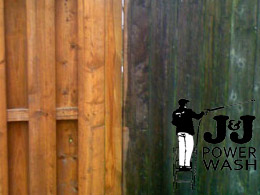
PRIMER
Before you paint, you must prime. Use a primer when painting over new wood or bare wood, or when repainting over bright or dark colors.
When picking out a primer, read the label. Make sure it has excellent adhesion to your current surface, hides stains well, is blister resistant, dries quickly and has low odor.
If you are only touching up areas of your house you won’t need a lot of primer. One gallon usually covers up to 400 square feet.
PAINT SELECTION
Do you have oil or latex paint on your house? Peel off a large paint chip. If the chip bends slightly before cracking, it’s probably latex. Oil paint chips snap easily. If you’re still in doubt, take a sample to your local paint store and have them test it.
Latex paint is an environmentally safe paint made from a water-soluble base. It’s easy to apply and cleans up with soap and water. It dries quickly (one to two hours), is nontoxic, and expands and shrinks with weather changes. Most companies offer a low-VOC* (volatile organic compound; see note below) or no-VOC paint. Latex paint is the kind most commonly used by professionals.
Oil-based paint is very durable and water resistant and less susceptible to shrinkage. It dries slowly, usually taking 24 hours to cure. Over time, it becomes brittle, and the color fades. It’s highly flammable and is susceptible to mildew. It cleans up with turpentine or paint thinner and is considered hazardous to the environment. Never put a new coat of latex over an old coat of oil paint without properly preparing the surface by sanding lightly or washing with TSP** (trisodium phosphate; see note below), a common paint-prep cleaner, and then applying a latex primer. If you skip this step, your new coat of paint is guaranteed to peel.
PAINT SHEEN
Walk outside and look at your house color. Is it dull or shiny or somewhere in the middle? That’s the sheen of your paint. Sheen describes the degree of light reflection paint has.
If you like the current sheen, stick with that. And if you have the old paint, the label on the can will tell you what the sheen is.
If you have an older home, a flat sheen will hide most siding imperfections and is a good choice for the body of the house.
Satin — sometimes referred to as eggshell — offers a good combination of easy cleaning and moderate sheen. It works great for trim, window frames and surfaces that need routine cleaning.
If you want a sleek, eye-catching look, a gloss sheen is your preference. It cleans easily, and is great for high-traffic areas like door jambs and window casings. But it shows imperfections and can fade.
COLOR
If you are confident of selecting the right color combination, go for it. Otherwise, there are lots of resources to try. Many paint companies, for example, offer tried-and-true color combinations; online, lots of sites show possibilities. Or you may want to hire a color consultant, who would be less expensive than repainting the whole house again.
Once you have the colors you think you want, buy a few quarts and paint small areas directly on the house in different locations. Or make sample boards.
Take a look at the paint during several times a day. Light and shade dramatically change the color of your house.
If you see a color combination on another home, politely ask the homeowners if they will divulge their color selection and brand of paint. I recommend not matching the next-door neighbor’s color combo.
SPRAY/BRUSH
If you plan to paint the entire exterior or a large portion of your house, a paint sprayer is the way to go. But be prepared for long hours of prep work. Everything that will not be painted must be covered.
Spray painting overrides surface imperfections such as gaps and cracks much better than a roller or brush and provides a superior, even coat of paint.
For painting small areas, invest in high-quality paintbrushes rather than economy ones. The good ones apply paint more thickly and smoothly, and hide brush marks. They do not shed or fall apart.
A 4-inch brush with tightly packed bristles is best for siding when needed. And an angled sash brush 1 inch to 2 1/2 inches wide is perfect for trim, window frames and moldings.
PAINTING
One rule you should never break is painting on bare wood. You must prime first.
Paint within a 50 to 80 degree air AND surface temperature.
Avoid painting in direct sunlight unless early or late in the day. The slower the paint dries, the better it sticks.
It will cost more, but using primer and two coats of paint is the way to go. Two thin coats are more durable than a single thick one.
NOTES
* The U.S. Green Building Council’s Green Building Guide (greenhomeguide.com) has this information on VOCs: They are carbon compounds that evaporate at room temperature and react in sunlight to form ground-level ozone, an integral component of photochemical smog. VOCs can cause respiratory, skin and eye irritation; headaches; nausea; muscle weakness; and more serious ailments and diseases.
**TSP — trisodium phosphate — available at most paint and hardware stores, has been the cleaner of choice for decades because of its ability to cut grease. But it’s very strong and can cause irritation and even burns, so be sure to follow the manufacturer instructions for mixing, clothing and safety precautions. You can also request a Product Safety Data Sheet (also known as a Material Safety Data Sheet) from the retailer.
If you are in the Greater Philadelphia area and are in need of pressure washing, power washing, window cleaning, graffiti removal or vehicle cleaning services, contact our Philadelphia Pressure Washing company at 215-703-8306.
As Weather Changes, Homes Need Care
As Weather Changes, Homes Need Care
Posted Today 02:01 pm)
Each season homes go through changes in temperatures, weather conditions and aging. In order to keep all the components of a home running smoothly and to avoid costly repairs later, it’s helpful to conduct seasonal maintenance actions each season.
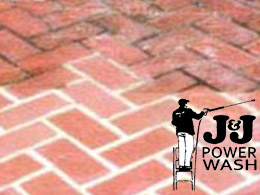
As the summer continues, this is a perfect time to prepare for fall.
Depending on the climate, the fall season may be too late to prepare if it gets cold quickly. Regardless of location, start these helpful tips now to save money and get a jump on the season.
* Examine the roof, gutters and downspouts for debris — The roof is often forgotten about because it is not at eye level to give a subtle reminder about maintenance. Clear leaves, dirt and pine needles from gutters and examine downspouts for damage or loose pieces — check the flashing around the chimney and any openings in the roof, such as skylights for leaking problems.
* Examine property grounds — Before the grass is covered with snow, or it is too cold to venture outside, check walkways for cracks and loose paver material. Fix walkway and entryway areas before slippery weather can cause a tripping or falling accident.
* Change the home filters — Those who have a central air conditioning system should change the air filter regularly. Those who have a window air conditioning unit should remove it from the window or place a waterproof cover over it to prevent damage. Change filters in stove vents, clothes dryers and room fans if applicable. Clean air filters will keep a family healthier in the fall months.
* Repair leaky faucets — Before the temperatures start to dip low, examine leaky faucets in the kitchen, bathrooms and utility room locations.
* Prepare the fireplace — Some people use the fireplace more than a central heater in the fall and winter months. Discard old ashes and ensure the damper is open to allow air to freely move through the chimney. If the air becomes cold, close back the damper after cleaning. Check the damper handle and springs to ensure the flue is operating correctly. Hire a professional chimney sweep if needed.
* Drain the hot water heater — Residential areas with extra amounts of hard water sediments could cause build up in the tank. Drain the tank and make sure rust is not developing. If the hot water heater is extremely old or is rusting, consider a new one that will be more cost effective and energy efficient.
* Check windows and doors for drafts — The majority of conditioned air in the home is lost through the windows and doors. Check the home and open windows to ensure the seal and caulking around the window frame is in good condition. Think of adding heavier drapery around windows that are extra drafty, to help block some air infiltration.
* Clean and store seasonal outdoor furniture — Power wash the outdoor furniture and cushions. Once dry, store cushions in dry area to prevent cracking and fading over the fall and winter months.
* Have garden power tools serviced — Once grass begins to enter the dormant stage, sharpen the blades on the lawnmower, trimmer and other tools and get engine fluids recapped off. When shopping for new garden power tools, buy when the season is almost over for cost cuts.
* Take care of irrigation and lawn needs — Depending on where residential region, the climate for the lawn and its irrigation system may need to be checked. Consider hiring an irrigation service professional to fix broken heads before the cold weather sets in. Fertilize to prevent spring weeds and winter lawn damage.
Visit a local garden center to find out information on what type of fertilizer to use and when to spread it.
If you are in the Greater Philadelphia area and are in need of pressure washing, power washing, window cleaning, graffiti removal or vehicle cleaning services, contact our Philadelphia Pressure Washing company at 215-703-8306.
Sticky Deck Problem Raises More Questions
Sticky deck problem raises more questions
Bill Burnett,Kevin Burnett
Wednesday, August 31, 2011
Recently we published a response to a reader who had a problem with a sticky deck. It seems her handyman didn’t read the instructions on the sealer can and got carried away. In this case, more was not better. The sealer pooled and dried to a sticky film.
We told our reader to give the spots a good scrubbing with acetone (lacquer thinner), rinse and finish with a light sanding. As often happens, a question begets more questions and different answers.
Here’s what this column generated:
Q: You mention redwood in your article. Our deck is cedar, which splinters a lot. I have had it power washed in previous years, but I think that might have made it worse. How would you treat a cedar deck?
A: The same as a redwood deck. Power washing with no sealer makes for dried-out wood and splinters. Power-wash the deck, let it dry and apply a sealer. As we’ve said many times before, we’ve had good luck with Duckback and Preserva Wood products. ( www.preservaproducts.com and www.superdeck.com).

Q: I saw your article and have a question: My deck is made from pressure-treated wood. In the past when I have applied deck stain, it looks great for a few months, then starts to wear off. By the next summer it looks as if it never penetrated the wood. Is that because the wood is pressure treated? Will the Preserva Wood or Duckback product do a better job than the product I have been using?
A: If the product you have been using is deck stain, the answer is yes. Stain will not penetrate pressure-treated wood. Pressure-treated wood is infused with a chemical preservative under pressure to prevent fungus and insect damage. If you cut a piece of PT lumber and look at the cut end, you’ll see 1/16 inch to 1/8 inch of penetration of the preservative. This prohibits water and stain from penetrating. If you continue to stain, count on a yearly project.
An old salt offered this suggestion:
“An old boat trick for too much sealer (tung oil or urethane) applied to teak decks: Apply 90 percent rubbing alcohol with bronze steel wool. It couldn’t hurt to try it on a small patch. Rubbing alcohol is cheap.”
We agree. It sure won’t hurt, and if it works, you won’t have to glove up and use a respirator, which you’ll have to do if you use acetone.
Finally, a manufacturer of wood stain pitched his product for cleaning up mistakes:
“I believe I have a safe and environmentally friendly solution to his predicament. We manufacture Penofin, a wood stain that is similar to Preserva Wood. A few years ago we launched a line of cleaners to help consumers prep their wood prior to staining as well as solve the more common problems associated with over-application.
“A sticky or tacky deck is usually due to over-application or failing to wipe the excess stain from the surface of the wood. We recommend our Penofin Pro-Tech Cleaner Step 2. This is a product that comes in powder form. You mix 1 cup to a gallon of water, wet the wood and apply the solution to the wood surface. Agitate lightly with a stiff bristled non-metallic brush for approximately 15 minutes. Rinse thoroughly with a garden hose and spray nozzle, and let the wood dry. This removes any tackiness or residue.”
We haven’t used this product, so for us it’s neither a pick nor a pan. We would probably give it a try. If it works it’s a good “green” way to go. If you would like more information, the website is www.penofin.com.
Read more: http://www.sfgate.com/cgi-bin/article.cgi?f=/c/a/2011/08/30/DDG91KQR4P.DTL#ixzz1WcgtbzP5
If you are in the Greater Philadelphia area and are in need of pressure washing, power washing, window cleaning, graffiti removal or vehicle cleaning services, contact our Philadelphia Pressure Washing company at 215-703-8306.

